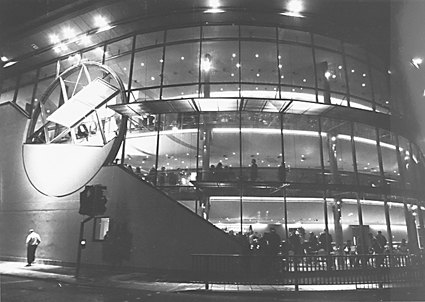 |
Arc, Stockton-on-Tees photo Chris Lutherland |
Northern Arts Board, however, with typical Northern gusto, has wasted no time. With perhaps the most to gain from distancing itself from the London-centric policies of ACE, NAB has finished its consultation with regional stake holders ahead of its fellow RABs and will distribute its funds through regional promoters, rather than directly to organisations in 1999.
Arc is a regional promoter with strong credentials, taking over from the small scale Dovecot Arts Centre, which for 25 years battled to provide for Stockton. Looking like a UFO in its chrome and steel incongruence with this drab, post-industrial city, Arc is one of the first wave of major capital developments funded by the National Lottery. It may have opened several months behind schedule, and over budget, but it has opened on this side of the millennium and that is a triumph for the North, as other beleaguered projects, such as the Royal Opera House in London, sink ever deeper into compromise.
With the ambition which has characterised the Stockton International Festival, also directed by Arc’s Chief Executive, Frank Wilson, Arc has set its world class standards, with an inspirational programme to match its superb facilities. Arc’s curving circumference contains a theatre, a music, comedy and cabaret venue, a cinema, a studio theatre, dance studio and recording studio for community and education use, 3 bars and a health club. Most importantly, Arc boasts a digital editing suite and all the equipment needed for the production and distribution of video and multimedia arts throughout the building. These facilities distinguish Arc as one of the first venues in the UK to place new media arts in a mainstream context, and the Mirror Images programme which opened the venue in January 1999, proudly celebrated the central role of digital arts within the organisation.
The season took its name from Richard Land’s interactive video installation, which was commissioned by Arc to showcase the potential of its facilities. Triggered into action by the images of passing viewers on a monitor screen, the installation evolved over time as ghost images of previous visitors accumulated. Architect Richard Wilson’s intervention into Arc’s facade, Over Easy, was another example of the playful nature of the opening commissions. Wilson’s first permanent installation in the UK revolves in Arc’s glass frontage, inviting visitors to sample the non-stop artistic activity within. Again employing ideas of access and community, Arc commissioned Danish group Hotel Pro Forma to work with local people to create imagery and sounds for the audio visual spectacular Tall Storeys High which illuminated the building over its opening week. Marcel Li Anthunez from Barcelona performed his Epizoo mechanical masterpiece of Stelarc-like physical manipulation; Motherboard from Norway presented Maggie’s Love Bytes, an internet link up with remote international participants; and British multimedia collective Black Box set up an exhibition of interactive sound and video work in the studio. Random Dance Company presented the world premiere of their new dance and digital media production Sulphur16, featuring graphic animation and film edited in Arc’s virgin studios.
Complementing the digital season, Arc’s inaugural programme features exciting new work in more conventional media: Jumping the Waves was commissioned from local playwright Gordon Steel; The Gandini Juggling Project premiere their new piece Remembering Rastelli; amongst several visiting national touring companies, Union Dance and Northern Broadsides Theatre present Dance Tek Warriors and Twelfth Night respectively; there is an extensive music programme and the comedy, club and cinema calendars are full of events likely to bring mainstream audiences into contact with new media work. Arc’s commissions will tour internationally and artists everywhere will benefit from this pioneering approach to new media programming. Symbolism aside, Arc seems set to play an inspirational regional, national and international role.
New centres for digital arts mean new opportunities for media artists to create and present their work in conditions conducive to their appreciation. Funding from the National Lottery has significantly improved audio and video technologies in auditoria and public spaces across the UK, and in several cases, such as Arc, included digital production facilities for the creation of work on-site.
The facilitation of digital arts creation is happening across the board, in venues large and small. In 1998, The Junction, a small arts centre in Cambridge, reopened with an impressive international digital programme. The new Sadlers Wells in London included a multimedia screen and an interactive installation in its foyer and is planning a digital programme for its studio Bayliss Theatre. In March 1999, The Lowry Centre in Salford Quays opened its doors to artists from MIT Media Lab, with a programme of residencies developed in conjunction with the commercial Digital World Centre next door. Future openings, such as The Baltic Flour Mills in Newcastle or the new Tate Gallery in London promise great opportunities for digital artists, with better residencies, showcases and schemes for audience development and marketing of media arts. Existing organisations, such as arts festivals, are catching the new media wave and offering commissions to performance and visual artists to create site specific interventions, often employing the digital media they have also acquired from smaller National Lottery capital applications. There is much to excite the British media artist at the moment, and more to come.
RealTime issue #32 Aug-Sept 1999 pg. 28
© Sophie Hansen; for permission to reproduce apply to [email protected]








 back
back